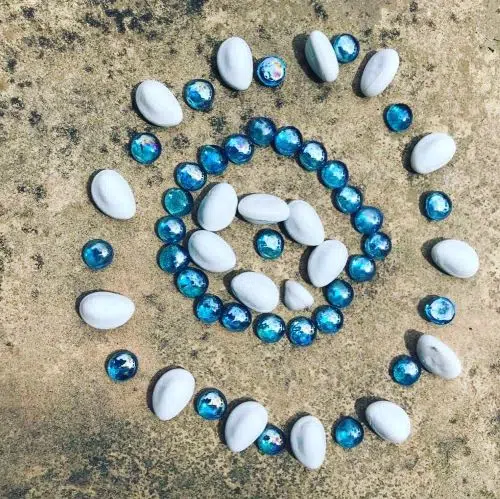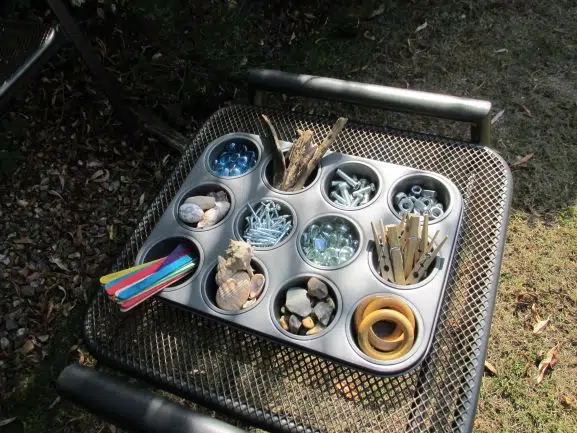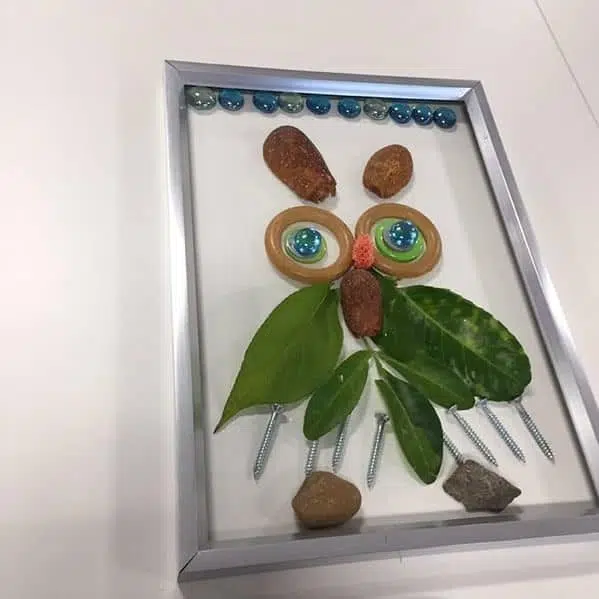In my twelve years of teaching children aged 3 to 5, I’ve used transient art opportunities in my learning environment more or less continually.
It’s just fantastic!
It offers a way of:
- Constructing and deconstructing
- Exploring ideas
- Experimenting with shape and form
- Storytelling
- Talking through their ideas
- Being creative
- And exploring famous art and artists
To give children ideas, it is a great idea to share with them examples of transient art by famous artists.
By simply sharing pictures, and talking about what the children see, you can get the children really engaged in transient art, and explore lots of different possibilities.
My 6 favorite transient artists and famous art examples to explore are:
1. Andy Goldsworthy – Land and nature art
2. Matisse – Cut-outs
3. Picasso – Assemblage
4. Walter Mason – Leaf art
5. Richard Long – Stones art
6. Bill Dan – Balancing rocks
In this post, I’ll dive into some fantastic works to share with children, and some of the key features to talk about. These projects would be great for all children from the age of about 3 to 9 – just do the project in a different way depending on the age of the children.

What is Transient Art?
Transient art is quite simply art that is not fixed or permanent.
It is often a collection of objects that are arranged in a certain way only for a fleeting moment of time.
This type of art is perfect for children, as they can construct and deconstruct artworks over and over.
How Do Children Engage With Transient Art?
When children engage with transient art, the emphasis is the moment of creation, rather than the finished artwork.
The simplest way to create transient art is with loose parts or other random objects.
Have some kind of tray of random objects, such as this:

You use the objects to make art.
Picture frames are also a beautiful way to help children structure their transient art-works.

You can use smaller objects for indoor transient art, and large objects for outdoor (as their art can be bigger outside).
Have a range of resources that link with the artworks and artists below:
7 Famous Transient Art Examples (With Artists)
1. Andy Goldsworthy
Andy Goldsworthy really is the King of Transient Art, and I would recommend starting the children with his works.
They really are a treasure trove of ideas, but also have an element of simplicity as well.
For a bit of context, Andy Goldsworthy was born in 1956. He is from the UK, originally living in Cheshire, but since moving to Scotland.
He is most well-known for his nature ‘sculptures’.
According to ‘Artnet’ (Source) Goldsworthy, ‘crafts his installations out of rocks, ice, leaves, or branches, cognizant that the landscape will change.’
He creates beautiful patterns and colorful effects.
This kind of art is brilliant for children that enjoy positioning schemas (placing objects next to each other).
His art is both about nature and also about time. So after he has created something, he documents how it changes over the coming weeks and months.
As Artnet put it, ‘He carefully documents the ephemeral collaborations with nature through photography.’
A good way to introduce children to Goldsworthy is just to google some images by him, pick one, and show it to the children.
Or you could talk through a slideshow video such as this one:
How To Use These Ideas:
Print out a picture, and have a selection of natural materials that mimic what you see in the artwork. The children can use the same resources to create their own interpretations
2. Matisse Cut-Outs
Now on to the one that I have probably used the most in my education career – Matisse Cut-outs.
Henri Matisse (31 December 1869 – 3 November 1954) was a famous French artist, and one of the founding fathers of modern art. (Source)
In his later years, he developed a style of art called cut-outs.
He was in his late seventies when he first began this style, was bedridden, and wasn’t able to access paints and canvases the way he had previously.
He took to sitting in bed and cutting into giant sheets of brightly colored paper with huge shears.
He then arranged these colored shapes into artworks.
Technically these are not transient artworks, as they are fixed. However, they can be the inspiration for transient art.
Here is a video of him in action:
Some great examples to show the children include:
–Snail (which you can view here)
–The Sheaf (which you can view on this site)
But you can literally just google ‘Matisse cut-outs’ and see what takes your fancy.
How To Use These Ideas
- Have a large printed picture
- Offer a selection of loose parts in similar colors. For example, if you were doing the ‘Snail’, then some brightly colored pegs, leaves, gems, or any other type of loose part would work well
- Using picture frames works really well for this type of transient art
3. Picasso Assemblage
This is another huge wealth of potential ideas for inspiring children.
Picasso (25 October 1881 – 8 April 1973) is of course one of the biggest names in the history of art. Born in Spain, he lived for the majority of his artistic career in France.
Picasso’s assemblage constructions were literally combinations of random objects and junk that he combined to create a sculpture.
He would regularly make them from objects he found in scrapyards.
Google ‘Picasso Assemblage’ and you’ll see the sorts of things he came up with.
Picasso created sculptures out of metal, wood, cardboard, boxes, spoons, kitchen appliances, poles, nails, screws – pretty much anything he could find.
All these objects took on their own significance.
A great example is his ‘Head of a Bull’ (Which you can see here).
Which is quite simply made out of a bicycle seat for the head of the bull, and a pair of handlebars for the horns.
How To Use These ideas
Show the children some examples of these types of sculptures
Have plenty of random objects available in a transient art learning area.
4. Walter Mason
Mason is a contemporary artist, based in Berlin.
His main resource is using leaves in his artworks.
Mason will cut patterns into leaves, as well as geometric designs. He joins the leaves together or arranges them in patterns.
It is a very simple and child-friendly form of art.
Also, it is truly transient art, in that his artworks are only temporary.
It has been described that ‘This organic art is only temporary – a fleeting moment of organization in a seemingly chaotic world.’ (Source)
How to Use These Ideas:
I’d recommend googling ‘Walter Mason Leaf Art’, and picking some examples.
Then either print the examples or show the children on a screen.
Have a selection of leaves, and things to make holes in them – for example, hole punches that make differently shaped holes.
5. Richard Long
Sir Richard Long (born 2 June 1945) is a British sculptor.
Wikipedia describes how, ‘His work typically is made of earth, rock, mud, stone, and other nature-based materials. In exhibitions, his work is typically displayed with the materials or through documentary photographs of his performances and experiences.’
Long creates arrangements of natural objects such as stones, in a range of patterns.
He has done artworks in a range of different countries, and the different landscapes give a specific flavor to each work.
For example, he created a ‘Sahara Circle,’ which was quite simply a circle of large sandy rocks in the Sahara desert.
Here is a slideshow video that will give children some inspiration about the type of art that he creates:
How To Recreate His Art
- Have a selection of natural objects – particularly stones, sticks, leaves, and that kind of thing
- Attempt both indoors and outdoors, but outdoors can be on a larger scale
6. Bill Dan
Bill Dan is a contemporary sculptor from San Francisco.
He specializes in balancing rocks in a multitude of formations.
Here is a video of him in action:
This video would be an ideal introduction to Dan for children, as this format really gives them a sense of the moveable nature of Dan’s work.
His sculptures are living, continually changing arrangements, and the children can see at least a glimpse of the creative process in action.
Dan tries not to overthink his work and emphasizes the simplicity of what he is trying to do.
Some Top Tips In Creating Transient Art With Children
You never really know what children will come up with when they try transient art, so here are some tips to get the best out of the experience:
- These artists are just for inspiration. The children don’t need to copy them – just adapt their ideas
2. Praise any efforts whatever they look like!
3. Ask questions about what they have created, but try not to interrupt the creative process too much when they are mid-flow. Questions are better delivered afterward, so they can talk you through what they have created
4. Create transient art both indoors and outdoors
5. Have a range of objects that the children can utilize independently
6. If doing transient art indoors, then have a range of picture frames for the children to use. These really help them to give structure to their creations
